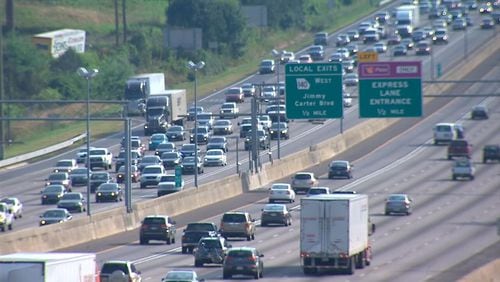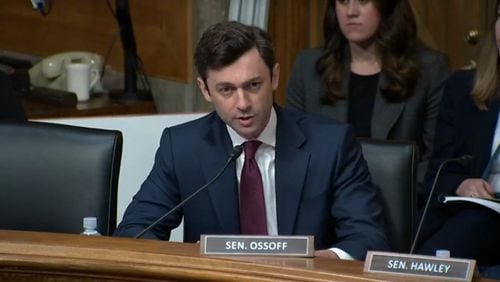The calendar hasn’t quite struck 10 years since the I-85 HOV lanes in Gwinnett county turned into variably-priced toll lanes. Normal people don’t keep track of infrastructure anniversaries, especially those that charge tolls. Well, unless we’re talking about the old GA-400 Toll Plaza coming down (that was November of 2013). Most folks don’t even remember what year that was either.
Just two years before the quarters stopped clanking in the toll booth, the cashless Peach Pass lanes debuted on I-85 between Suwanee and Chamblee. The HOV lanes on I-85 in Gwinnett, cost-free until October of 2011, allowed people with two or more people to use them and also allowed motorcycles, buses, and alternative fuel vehicles. Those lanes still exist on several Atlanta freeways. But the High Occupancy Toll (HOT) lanes require three or more in a vehicle to be used for free and those drivers have to set their “toll mode” to “3+.”
There was quite an outcry the autumn morning of the lanes being converted, since free lanes already paid for by taxes were now under the State Road and Tollway Authority’s (SRTA) domain. Sensors and cameras along I-85 on that stretch scan vehicles’ Peach Passes (barcoded transmitter stickers stuck up under rearview mirrors) and debit the money for the trips in the lanes. Drivers are charged by the segments they travel and are only allowed to enter and exit the lanes at certain spots. And those driving illegally in them eventually got citations sent in the mail, based upon license plate pictures.
Similar reversible lane systems have opened in recent years, with several differences.
The South Metro Express Lanes, opened in early 2017, are built separately from the general lanes, along I-75 between I-675 (Exit 227) and Highway 155 (Exit 216). This is a two-lane system, reversed normally twice per weekday, with fixed entry and exit ramps and gates that keep traffic from entering the wrong-way. These lanes do not allow price exemptions for carpoolers or those with alternative fuel options, but the lanes do keep big rigs out of them.
The I-75 and I-575 lanes, or the Northwest Metro Express Lanes, run from just inside I-285 (Exit 259) to just north of Wade Green Road (Exit 273) on I-75, reversible, and in a double-lane formation. I-575 sees a single, reversible lane between the I-75 interchange and Sixes Road (Exit 11). They operate with the same rules as the south side lanes and, too, are built separately, as added capacity along their freeways. These opened the day after Labor Day in 2018.
SRTA and GDOT reverse those lanes mid-morning and late-night for the forthcoming rush hour traffic flow and also in prediction of weekend, holiday, and special event patterns.
Pricing in any of these lanes is based upon demand and with the idea of keeping traffic in them moving faster and more predictably than the regular lanes. The I-85 HOT lanes in Gwinnett, expanded up to Hamilton Mill (Exit 120) in November of 2018, but those were in connection with widening the freeway. The traffic real estate on I-85 remained the same, however, between Highway 317 (Exit 111) and Shallowford Road (Exit 94), so traffic on that part of I-85 did not really improve after the HOT lanes converted. But traffic in the HOT lanes generally moves better, which has required an increasing price over the years, pre-COVID. SRTA Executive Director Chris Tomlinson, the Deputy Director when the lanes debuted, said that I-85 Peach Pass usage increased over four-fold since 2011 and before COVID-19. The pandemic-caused traffic pattern changes certainly took a bite out of their success, with usage in March 2020 dipping to 50% of what it once was statewide.
“Those declines continued and we hit an all-time low of about 82% reduction in trips in the lanes,” Tomlinson told the AJC and 95.5 WSB on the latest WSB Traffic Podcast. But trips have steadily increased since then and are at about 60% of the pre-pandemic levels, Tomlinson said.
Traffic statewide has returned to 85% of its volume before COVID, Tomlinson explained. And it will only rise as more people get vaccines and offices and schools continue to reopen.
I-75 in Henry County has seen the biggest percentage increase, as there are even more tractor trailers on the roads than this time a year ago. “About 105% more than pre-pandemic,” Tomlinson said. “The congestion in the south has come back even more quickly in the corridor,” Tomlinson explained, referring to the regular, non-toll lanes. “More people in their passenger cars are starting to take the toll lanes. Some people - it’s just to get away from the truck traffic. But it’s also for the lack of predictability for that congestion.”
The I-75 South Metro Express Lanes are especially valuable for vacationers. “I-75 south is the route to Disneyworld and all things Florida - and some pretty key NASCAR races,” Tomlinson said before explaining how he has driven his family quickly in the toll lanes, while traffic is dead-stopped in the general lanes. That’s extreme, but the entire 24/7 average speed increase in the Peach Pass lanes is still significant. “I-85 - the lanes move two and half to 10 miles per hour faster than the other lanes. I-75 - six miles per hour to 18 miles per hour faster. And oftentimes, faster than that,” Tomlinson stated.
SRTA has made Georgia’s Peach Pass functional with the Florida SunPass toll system and North Carolina’s Quick Pass lanes. And those states’ passes work in Georgia’s lanes. Tomlinson hopes to have Peach Pass and the 19-state E-ZPass system in the midwest and eastern seaboard integrated by the end of 2021. He also expects the Peach Pass to pay for some Atlanta Airport parking in the near future.
Express Lanes, not HOT lanes, are also in the cards for big swaths of GA-400, I-285, and I-20 in the next 10-15 years with more than just predictable speeds and revenue in mind. Tomlinson and GDOT Commissioner Russell McMurry have shared in recent years how the separate Express Lanes with their array of sensors and cameras, would be good fielding grounds for autonomous vehicles. Some of those could “platoon” together, which is where autonomous passenger cars can “talk” to each other and ride very close to one another like a train.
SRTA debuted the Peach Pass Go! 2.0 app and there were some struggles with some users getting integrated on the new platform. Tomlinson said that everyone needs a valid email address on the new app and if they have any issues, to contact Peach Pass customer service at 1-855-PCH-PASS (724-7277) or customerservice@peachpass.com.
State and local officials, including Tomlinson, who also oversees regional transit authority “The ATL”, are working to bolster all modes of transportation and integrate them. But improvements also continue on the roads that most people use and the Express Lanes are integral to that.
“This toll lane is helping lower the cost of these projects and by doing so, it helps the state accelerate how many different projects they can do at one time,” Tomlinson said.
Doug Turnbull, the PM drive Skycopter anchor for Triple Team Traffic on 95.5 WSB, is the Gridlock Guy. He also hosts a traffic podcast with Smilin’ Mark McKay on wsbradio.com. Contact him at Doug.Turnbull@cmg.com.
About the Author






